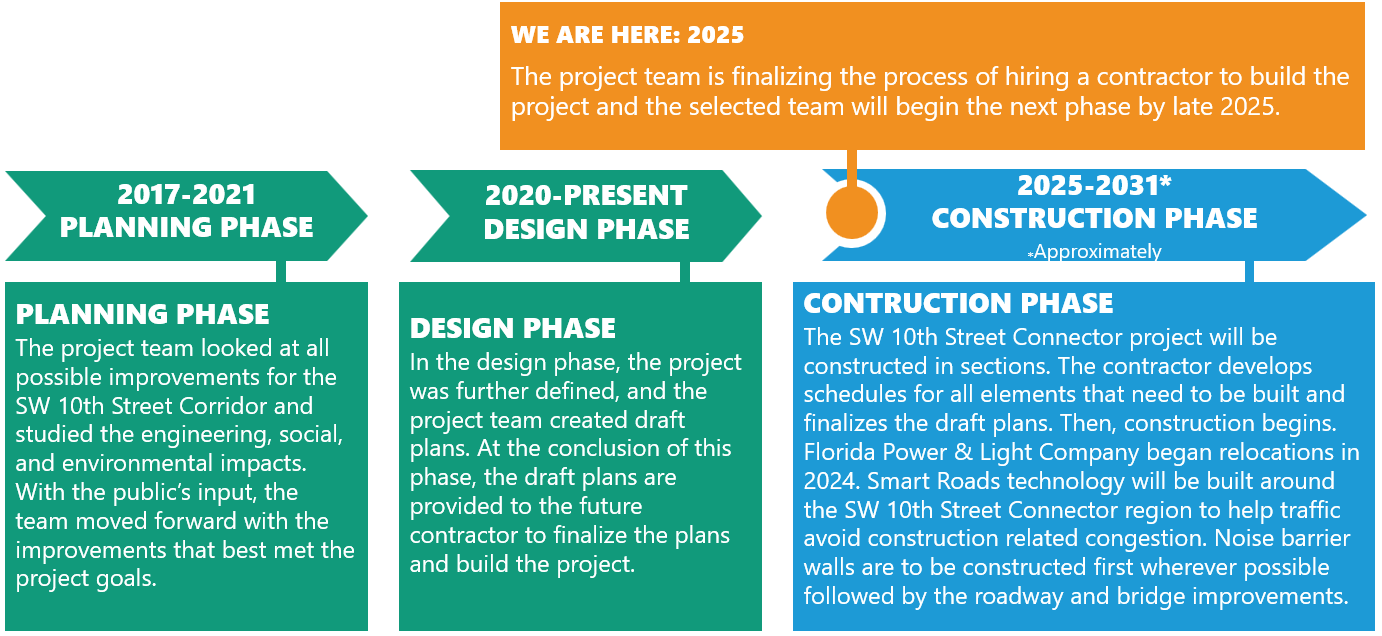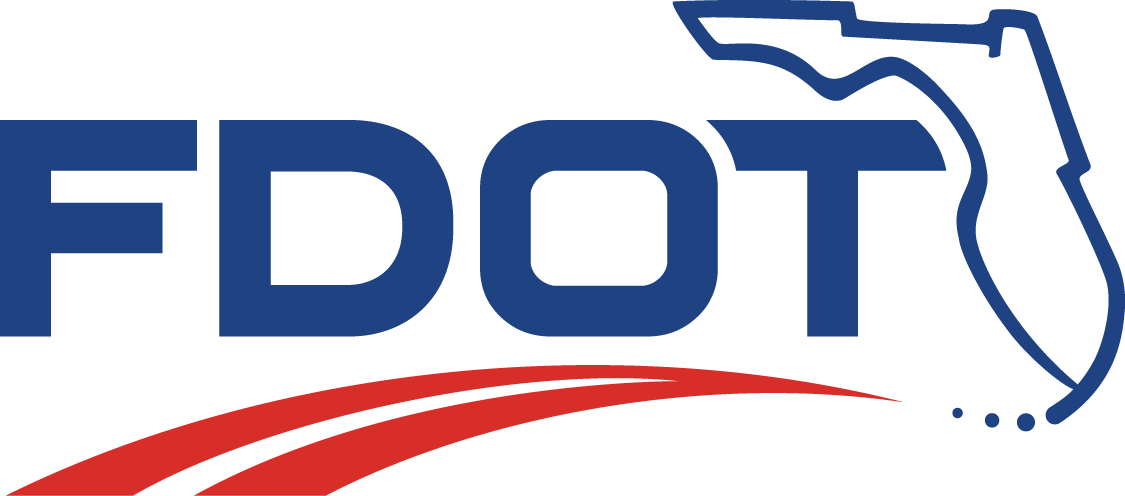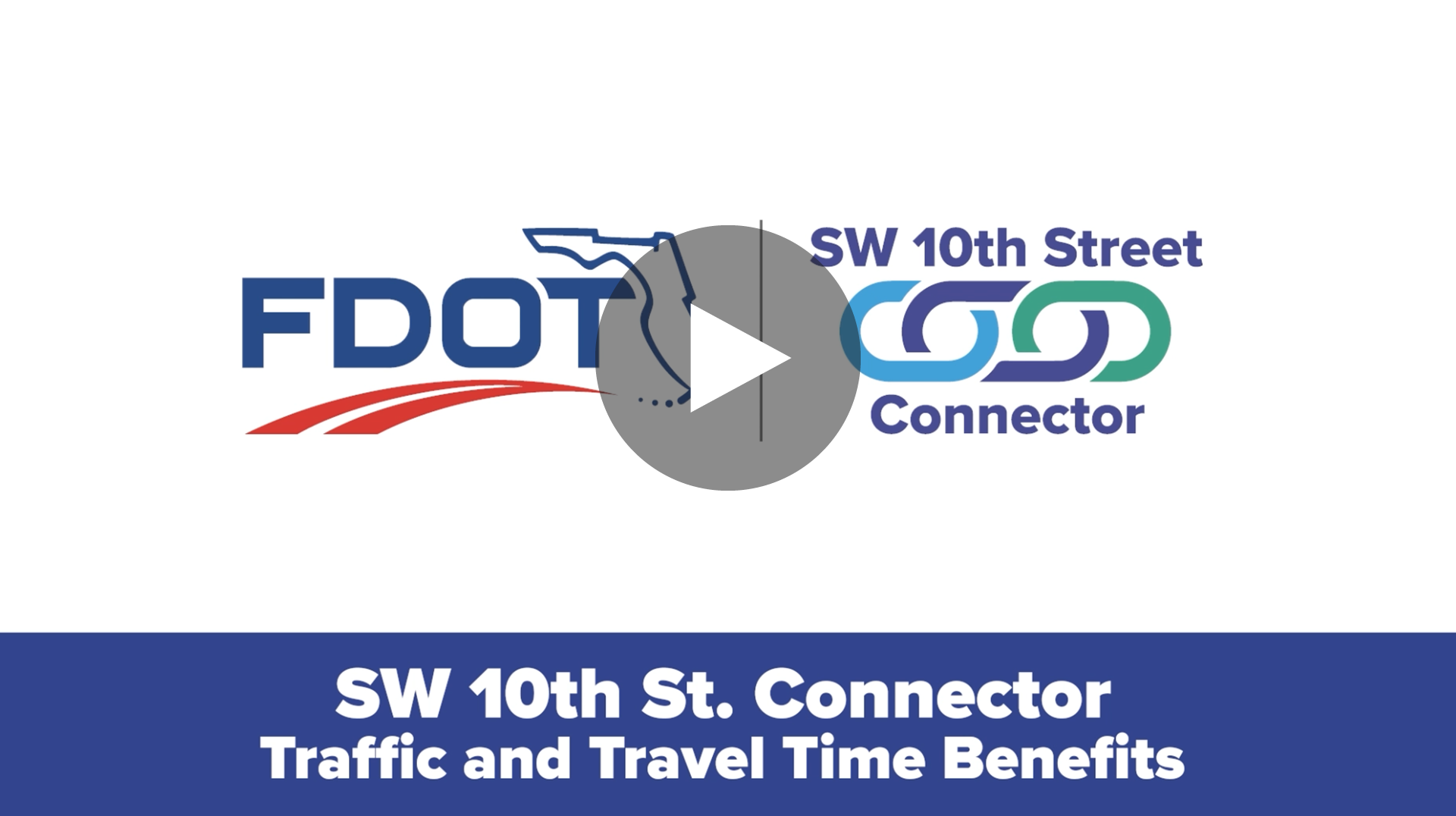Frequently Asked Questions
- The SW 10th Street Connector Project is a major roadway improvement project that will separate the major highway regional traffic from the local residential and business traffic. This configuration change will allow non-local traffic to bypass the corridor’s residential and commercial areas and innovatively improve several of the corridor's major arterial connections. One roadway, the SW 10th Street connector lanes, will improve regional connectivity between the Sawgrass Expressway and I-95. The other roadway, local SW 10th Street, will become a “Complete Street” that will incorporate a shared-use path and provide connectivity to all existing local properties and the local roadway network. The two roadways will work together to alleviate traffic congestion in the area, improve operations and safety, and provide improved evacuation operations. The connector lanes will be on the north side of the existing Right of Way, and local SW 10th Street as well as the shared-use path will be on the south side. The SW 10th Street Connector Project also includes improvements at the SW 10th Street and Hillsboro Boulevard interchanges. Further, it includes the addition of the second express lane in each direction on I-95, between Sample Road and Hillsboro Boulevard.

- The goals of the project include enhanced safety, additional accessibility and connectivity, better quality of life for residents, improved air quality, reduced congestion and commuting time, accommodation of regional population growth, improved emergency evacuation options, and provide for long term regional network connectivity.
- As a key regional connection in Broward County, Florida, SW 10th Street currently serves as a critical transportation corridor for all types of traffic – ranging from residential, commuter, commercial, truck, freight, bicycle, and pedestrian. While these three miles of SW 10th Street are a critical link between I-95 and the Sawgrass Expressway, the corridor’s current use is that of an arterial roadway, not the regional limited access facility that was first envisioned by planners in the early 1970s, or by Transportation officials in the 1980s when the land for the highway was purchased. Without construction, the average commuter through the current SW 10th Street corridor would sit in traffic for as much as 30 minutes every day during the evening rush hour, or up to 130 hours each year, which is unacceptable.
When complete, the SW 10th Street Connector Project will address the present safety and mobility challenges and provide that missing link in the region’s limited access highway network, alleviating congestion and giving you back that extra time – time better spent with your family and loved ones. This will be achieved by separating the major highway throughput traffic from the local traffic, allowing the regional commuter and other non-local traffic to bypass the residential areas of the corridor and innovatively improve several major arterial connections. Additionally, the project will reconstruct four intersections and one major interchange, including Powerline Road at Military Trail and SW 10th Street with I-95.
This graphic shows various travel times for the AM and PM peak hours:
- Existing travel times,
- Future travel times with no improvements,
- and Future travel times with the SW 10th Street connector lanes improvements.
Travel times are shown for roadway segment on SW 10th Street between the Florida’s Turnpike and I-95.

For more information on traffic and travel time benefits, please watch this video.
- Construction will take multiple years, with numerous individual segments of work being phased strategically to maximize safety and user experience as well as minimize impact to traffic during construction. Construction on this project began in late 2023 with advance utility relocations. Work on the corridor is expected to begin in 2025, beginning with ground mounted noise barrier walls. The total duration of work will depend on the innovations and proposals brought forward by the construction team. FDOT has developed prioritization incentives specifically to reduce the total duration of work along local SW 10th Street, including at intersections such as Military Trail, Newport Center Drive, and the I-95 service interchange.

- The SW 10th Street Connector Project is not expected to have any adverse environmental impacts on nearby public water supply wells. Additionally, carbon monoxide emissions that may result from this project are expected to remain within national air quality standards. Air and water quality studies were conducted for this project and no concerns were identified for the proposed improvements.
FDOT has practices in place to mitigate impacts to surrounding areas during construction. Dust impacts are reduced by watering construction work zones to avoid dust from leaving the work areas. Whenever possible and if approved by adjacent benefited properties, noise barrier walls would be constructed prior to roadway construction in order to reduce construction noise levels.
- Real-time traffic alerts: Smart Roads technology will advise motorists of potential congestion, major construction activities, and lane closures in advance. These alerts will be displayed via electronic message boards, mobile apps, and other communication channels.
- Alternate route recommendations: The system will notify motorists of recommended alternate routes to avoid the most complicated construction areas, particularly along SW 10th Street or I-95, to minimize construction related delays.
Motorists should anticipate occasional congestion and traffic delays during the construction of this project. To minimize these impacts, "Smart Roads" technology will be utilized to provide real-time updates to motorists, helping them better navigate potential traffic impacts. Key features include:
On I-95, FDOT’s Road Rangers will be available 24/7 to assist stranded motorists and remove disabled vehicles from travel lanes. These inconveniences will be temporary, and will result in a safer, less congested corridor and improve the quality of life for the residents of the region.
For more information on how "Smart Roads" can help you, please visit our informational fact sheet here.
- The SW 10th Street Connector Project team is required to keep all local side streets and driveways open throughout construction, with the exception of short-term closures for specific work directly at the crossing points. Access to and from businesses along the SW 10th Street corridor will remain when construction is complete, and any short-term impacts to access will be communicated to businesses and the public in advance.
- The Right of Way acquisition process as well as coordination with impacted property owners is underway.
The SW 10th Street Connector Project includes the acquisition of land for the creation of a stormwater management pond to enhance drainage and resiliency. This stormwater pond is integral to the project’s commitment to mitigating flooding risks and improving stormwater management for the area. In addition, private parcels are impacted in a few locations with no residential relocations anticipated.
Importantly, the project team has worked diligently to minimize any significant impacts to nearby properties and maintained open communication with stakeholders to address any concerns, creating a smooth acquisition process.
For more information on Right of Way acquisition, please contact the project manager, Vanita Saini, P.E. at Vanita.Saini@dot.state.fl.us or at 954-777-4468.
- The residential communities along SW 10th Street, between the Sawgrass Expressway and I-95, were evaluated for noise impacts. Nearly all of the communities warrant a noise barrier wall following the required state and federal process. As required by federal regulation, a survey must be sent to the properties that would benefit from a noise barrier wall, to confirm that they support the construction of a wall in their immediate vicinity. A majority of survey respondents must support its construction, prior to the State moving ahead with construction of the wall.
The communities of Century Village East, Waterford Homes, Waterford Courtyard, The Enclave at Waterways Apartments, Waterways at Quiet Waters, Independence Bay, and Freedom Square Condominiums have all elected for the inclusion of of noise barrier walls adjacent to their neighborhoods.
For more information on noise barrier walls, please visit this page.
- Different units along the SW 10th Street corridor would experience different levels of noise reduction from the proposed noise barrier wall system. The proposed noise barrier wall system would provide an average noise reduction ranging from 4.4 to 6.3 decibels and a maximum reduction ranging from 9.1 to 14 decibels. Reductions in traffic noise of 1 to 3 decibels are not considered noticeable to most people, while reductions of 5 decibels are considered readily noticeable.
- Yes. All existing noise barrier walls will be replaced with a new noise barrier wall. For a look at all the noise barrier walls along the project, please check out the noise barrier wall status map here.
- Yes. In fact, one of the main benefits of the SW 10th Street connector lanes is to separate regional truck/freight traffic from the local traffic, improving safety and mobility for those passing through the region and improving local residents’ commute and local road quality of life.
- The project includes reconstructing more than 2 miles of I-95 to accommodate the SW 10th Street connector lanes interchange with I-95. This project will also add a second express lane in each direction on I-95 between north of Sample Road and Hillsboro Boulevard, thereby completing the 95 Express system from downtown Miami to southern Palm Beach County.

- During the construction of the SW 10th Street Connector Project, FDOT will implement advanced Transportation Systems Management and Operations (TSM&O) technology, also known as “Smart Roads”, on roads surrounding the construction area that will allow us to communicate directly with motorists to help them efficiently maneuver through and around the construction areas.
This innovative technology will help FDOT monitor the status of traffic, support safety and mobility in the area, and provide congestion relief. The map below highlights the zone where portions of select state roads will be converted to “Smart Roads”. The technology improvements on the Smart Roads along with SW 10th Street and I-95 will remain operational after construction for the long-term benefit of the region. As such, the "Smart Roads" serve both a construction phase benefit and a long-term regional benefit for traffic management. For more information on how “Smart Roads” work, please visit our informational fact sheet here.
- As part of this project, bicycle and pedestrian facilities will be incorporated into Local SW 10th Street with a 12-foot-wide shared-use path, which will provide connectivity to all existing local properties and the local roadway network, along the south side of the existing right of way.
- The SW 10th Street Connector Project will be moving forward into the final design and construction phase with the selection of a Design-Build construction contractor. The contractor team will first be tasked to plan out all of the construction activities and sequencing of the work, as well as the construction timeline for the entire project. This pre-construction planning identifies which parts of the corridor will be constructed first for the most efficient work plan for the I-95 at SW 10th Street Interchange and the rest of the SW 10th Street corridor to the west.
While the pre-construction planning is going on, FDOT will implement advanced traffic management and optimization technology on select state roads surrounding the construction area that will communicate directly with motorists to help them efficiently maneuver through and around the construction area. These are also known as “Smart Roads”. This innovative technology will support safety and mobility in the area and provide congestion relief.
For more information on the “Smart Roads” construction phase traffic initiative, please see our Smart Roads informational fact sheet here.
- Information on this webpage (www.sw10street.com) will be updated as the project progresses. We also encourage you to sign up for email updates to receive a quarterly newsletter. Issues of the quarterly newsletter are available on the project website. Also, follow FDOT District 4's social media channels on Instagram, X (Twitter), and Facebook. If you have a question about this project that is not answered on the project website, please call us at 954-777-4468 or email at Vanita.Saini@dot.state.fl.us and we will respond as quickly as possible.


